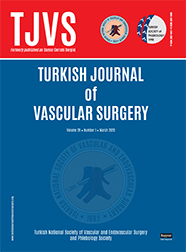
The Turkish Journal of Vascular Surgery
Yazarlar: Macit BİTARGİL, Hamit Serdar BAŞBUĞ, Hakan GÖÇER, Yalçın GÜNERHAN, Ahmet KARAKURT
Konular:-
Anahtar Kelimeler:Aneurysm,False; coronary angiography; complications
Özet: Objective: Our aim was to share our experience, and discuss prevention and treatment of vascular complications that occur after coronary angiography. Material and Methods: A total of 2028 patients had coronary angiography between January 2013 and June 2014, 75 of (3.6%) them [47 males (62.7%), 28 females (37.3%)] with a mean age of 58.8± 8.9 (range 36-78) years had vascular complications, and they were analyzed retrospectively. Complications were classified as pseudoaneurysms handled via surgical treatment (n=7, 9.3%), pseudoaneurysms handled via ultrasound guided compression (n=22, 29.3%), distal emboli (n=1, 1.3%), deep vein thrombosis (n=1, 1.3%), hemorrhage (n=21, 28%), hematoma (n=23, (30,7%), infections (n=0), and arteriovenous fistula (n=0). Treatment strategies were classified according to the complications. Results: Eight patients (0.3%) were treated surgically. One patient was treated via femoral embolectomy due to suspicion of thromboembolism. Seven patients were treated surgically due to pseudoaneurysm. In two cases, common femoral artery graft interposition and embolectomy procedure were applied. Iliofemoral graft bypass surgery was applied in one case. Remaining four patients with psuedoaneurysms were handled surgically via primary repair. The diameter of the psuedoaneurysms was 52.4±17.8 mm, with a range of 38-55 mm. Conservative treatment was used in 67 patients. Among them, 22 patients had minimal hematoma, and they were handled by ultrasound guided compression therapy. In 21 patients who were developed hemorrhage, fresh frozen plasma, and vitamin K therapy were administered, anticoagulation was stopped and compression therapy was applied. In 23 patients with hematoma, leg elevation and compression therapy were applied. In one deep vein thrombosis patient low molecular weight heparin and oral warfarin therapy were applied. None of the patients had arteriovenous fistula, infection or mortality. Conclusion: Vascular complications following coronary angiography are rarely seen. Precautions may reduce the number of complications. Precise and acute handling of the complications is important for extremity salvage, and will reduce the morbidity and mortality.